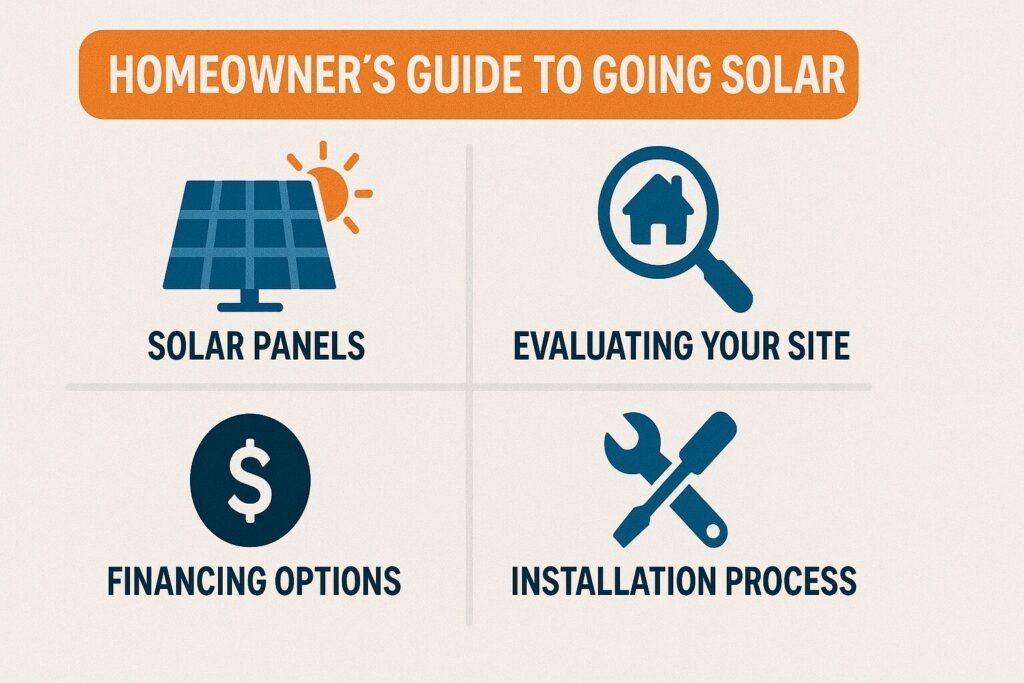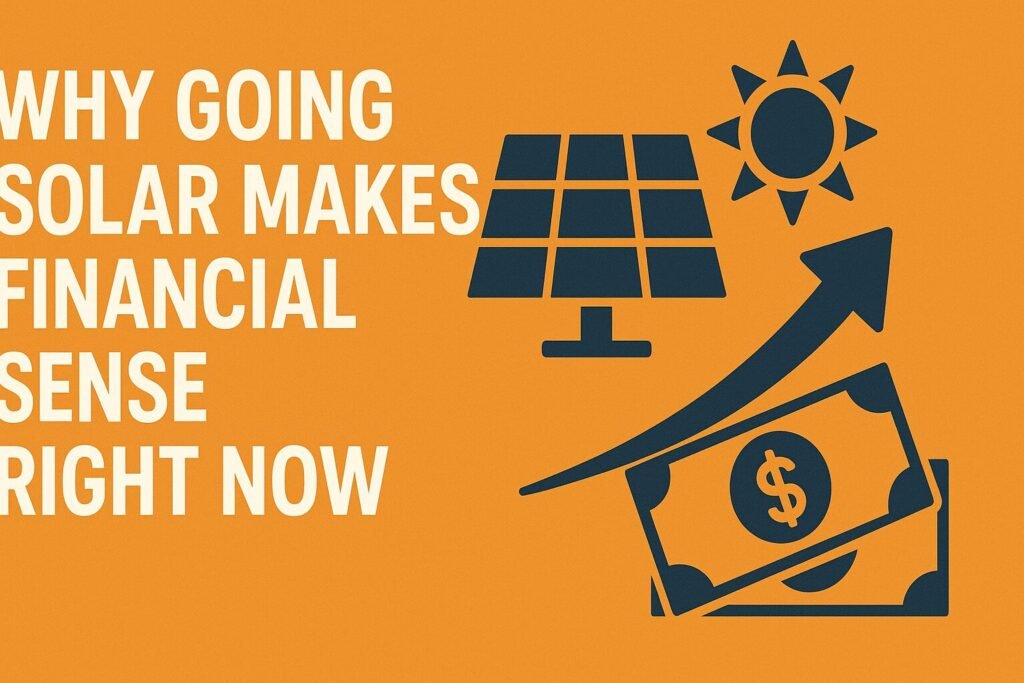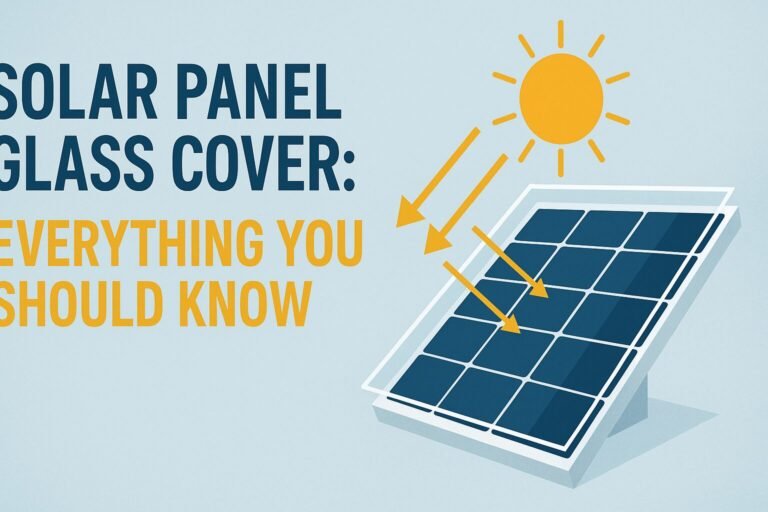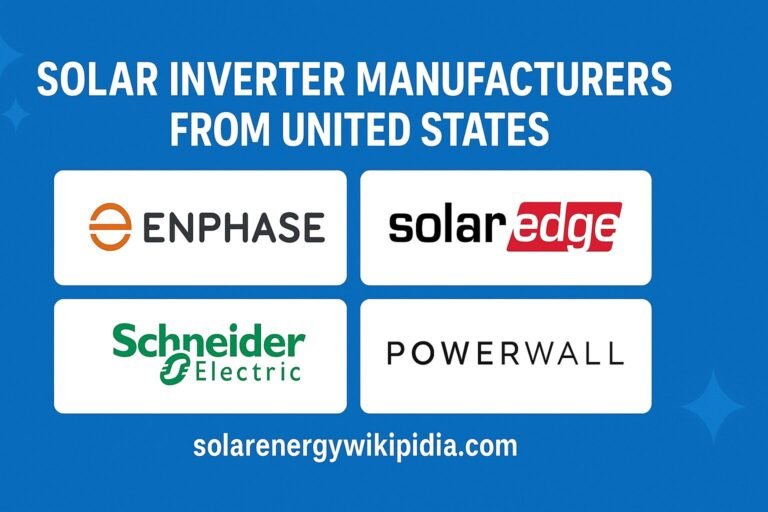
Discover everything you need in this homeowner’s guide to going solar panels – costs, installation steps, benefits, and FAQs for 2025.
Going solar feels overwhelming, doesn’t it? You’re staring at your monthly electric bill wondering if those shiny panels on your neighbor’s roof are really worth the investment. Here’s the truth: solar isn’t just trendy anymore—it’s become a game-changer for smart homeowners.
This homeowner’s guide to going solar panels will walk you through everything you need to know. No technical jargon, no sales pitch—just real talk about making one of the best investments for your home and wallet.
Table of Contents
Quick Solar Overview: What You Need to Know
| Solar Panel Factor | 2025 Details |
| Average System Cost | $30,000 before incentives |
| Cost After Tax Credits | Around $21,000 |
| Installation Timeline | 2-6 months total process |
| Federal Tax Credit | 30% through 2032 |
| Typical System Size | 6-8 kilowatts for average homes |
| Break-even Period | 6-10 years in most areas |
Why Going Solar Makes Financial Sense Right Now

Let’s be honest—the upfront cost makes your heart skip a beat. But this is what completely shifted my perspective.
The math is brutal for NOT going solar. Your electric bill isn’t getting cheaper. In fact, utility rates climb about 3% annually while solar prices have plummeted 70% over the past decade.
Sarah from Phoenix told me her family saves $180 monthly after going solar last year. That’s over $2,000 yearly—money that stays in her pocket instead of disappearing to the utility company.
The Hidden Costs You’re Already Paying
Every month without solar, you’re essentially renting electricity at rising rates. Meanwhile, solar owners lock in their energy costs for 25+ years. It’s like choosing between renting forever versus buying your dream home.
## Understanding Solar Panel Costs in 2025
The sticker shock is real, but let’s break down what you’re actually paying for in this homeowner’s guide to going solar panels.
What Drives Solar Panel Pricing
System costs range from $18,000 to $43,000 depending on several crucial factors:
System Size Matters Most
Bigger homes need more panels, obviously. But there’s a sweet spot where economies of scale kick in. Smaller systems actually cost more per square foot because installation overhead gets spread across fewer panels.
Your Roof Tells the Story
Complex rooflines with multiple angles cost more to install. Simple, south-facing roofs with minimal shading? You’ll spend less while producing more power.
Location, Location, Location
California homeowners might pay more upfront but save more long-term due to higher electricity rates and better sun exposure.
Hidden Costs That Catch Homeowners Off-Guard
Nobody talks about the sneaky expenses until you’re deep in the process:
- Roof repairs before installation: $500-$2,000
- Electrical panel upgrades: $1,500-$3,000
- Panel removal for future roof work: $1,000-$3,000+
## The Complete Solar Installation Process
This homeowner’s guide to going solar panels wouldn’t be complete without walking through what actually happens during installation.
Phase 1: Assessment and Design (Weeks 1-2)
Your solar journey starts with a detailed home assessment. The installer examines your roof condition, electrical panel, and energy usage patterns.
Analyzing your electricity bill is crucial because it determines your system size. Don’t skip this step—undersized systems leave money on the table.
What They’re Really Looking For:
- Roof structural integrity
- Shading patterns throughout the day
- Electrical panel capacity
- Optimal panel placement angles
Phase 2: Permits and Paperwork (Weeks 3-6)
Here’s where patience becomes your best friend. The permitting process often determines your timeline more than actual installation.
Your installer handles most paperwork, but you’ll need to:
- Sign interconnection agreements with your utility
- Apply for local building permits
- Submit HOA applications if applicable
Phase 3: Installation Day (1-3 Days)
The actual installation feels anticlimactic after all that waiting. Most roof installations take just a day or two.
Hour-by-Hour Breakdown:
- Morning: Crew arrives, sets up safety equipment
- Mid-morning: Mount installation begins
- Afternoon: Panel placement and wiring
- Late afternoon: Inverter connection and testing
Phase 4: Inspection and Activation (Weeks 1-4)
Your system can’t legally produce power until passing inspection. Local authorities inspect electrical connections and ensure safety compliance.
Once approved, your utility installs a net meter. This magical device tracks electricity flowing both directions—into your home and back to the grid.
## Maximizing Your Solar Investment
Smart homeowners know that installing panels is just the beginning. Here’s how to squeeze every penny from your investment.
Timing Your Solar Installation
Install during fall or winter when contractors offer better pricing and scheduling flexibility. You’ll be generating power by spring when rates typically spike.
Energy Usage Optimization
Solar works best when you shift energy-heavy activities to daylight hours. Run dishwashers, laundry, and pool pumps during peak sun periods.
Lisa from Colorado programmed her water heater timer to coincide with solar production. This simple change boosted her savings by 15%.
Monitoring and Maintenance
Modern systems include smartphone apps showing real-time production. Watch for sudden drops indicating dirty panels or equipment issues.
## Common Solar Myths Debunked
Let’s destroy some persistent myths in this homeowner’s guide to going solar panels.
“Solar doesn’t work in cloudy climates”
Germany leads global solar adoption despite having limited sunshine—panels produce electricity from all daylight, not just direct sunlight.
“Panels damage your roof”
Professional installation actually protects your roof. Panels shield shingles from weather while proper mounting prevents leaks.
“Solar maintenance is expensive”
Panels need occasional cleaning and annual checkups. Total maintenance costs average under $200 yearly.
FAQs: Homeowner’s Guide to Going Solar Panels in 2025
How long do solar panels really last?
Quality panels come with 25-year warranties but typically produce power for 30+ years. With an average degradation rate of 0.5% per year, panels maintain about 85% of their efficiency after 25 years.
What happens during power outages?
Standard grid-tied systems shut down for safety during outages. Adding battery storage keeps essential circuits powered, but increases costs significantly.
Will solar work with my HOA?
Most states have “solar rights” laws preventing HOA solar bans. However, HOAs can impose aesthetic requirements affecting panel placement and appearance.
Can I install panels myself?
DIY installation voids warranties, creates safety risks, and complicates permits. Professional installation ensures optimal performance and maintains insurance coverage.
How do I choose the right installer?
Research local companies with proper licensing, insurance, and stellar reviews. Avoid door-to-door salespeople and high-pressure tactics. Get multiple quotes and compare warranties, not just prices.
Going solar represents more than just installing panels—it’s claiming energy independence and making a statement about your family’s future. This homeowner’s guide to going solar panels hopefully cleared up the confusion and gave you confidence to take the next step.
The technology works, the economics make sense, and the environmental benefits feel incredible. Your only regret might be not starting sooner.
Ready to join the solar revolution? Start by requesting quotes from three local installers and comparing their proposals. Your future self will thank you for taking action today.





